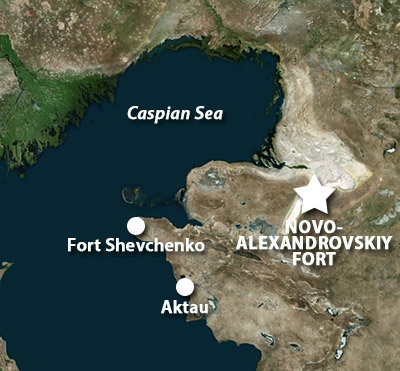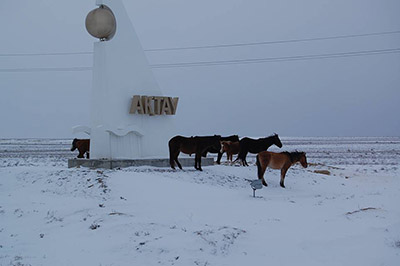 |
Novo-Alexandrovskiy Fort
Mangystau Oblast, Kazakhstan
|
|
 |
Constructed: 1834
Used by: Russia
Conflicts in which it participated:
None
|
Poking into the Caspian Sea from the east is the Mangystau Region of Kazakhstan. This region was named for a fort: Fortress Mangyshlak existed somewhere on the peninsula from the 10th to 13th centuries, and was a major trading post.
The Caspian Sea is the largest "enclosed inland body of water" on the planet, and has been recognized as an oil-rich region since at least the 10th century. Mineral oil was considered to be an interesting and useful product of the earth for centuries, but when the Industrial Revolution started turning people into fire-breathing machines in the late 18th century, oil was suddenly a strategic commodity that every modern nation was desperate to possess. |
 |
 |
|
Russia naturally had an interest in all of this oil that was so tantalizingly close to its conveniently indistinct borders, and had been making efforts to tame the Mangystau Region since the late 17th century, by building forts forts forts. Lots of shaggy little guys on shaggy little horses had been making things all wild 'n' wooly in most of central Asia for thousands of years, however, and it took some time to make them see the error of their nomadic, shaggy ways.
Visions of oil wells dancing in its head (and as part of an ongoing effort to conquer Central Asia), Russia embarked on a new military and explorative expedition into the Mangystau Region in the 1830's and 40's, in which a series of starforts were built along the banks of the Caspian. One of these was Novo-Alexandrovskiy Fort, the tragic starfort of our current interest, built on what was at the time a waterway emanating from the Caspian Sea. A shallow port was briefly in operation under the guns of this fort.
|
 Mangystau Region's Coat of Arms, which was assumedly drawn by a caveman, not a modern five-year-old. |
 |
At about the same time, a fort named Novo-Petrovskoye was built on the tip of the peninsula. This fort would be renamed Fort Alexandrovskiy in 1859 and has been known since 1939 as Fort Shevchenko, after Ukranian poet and artist Taras Shevchenko (1814-1861). Shevchenko had written a poem in which Tsar Nicholas I (1796-1855) and the Tsarina were referenced in an uncharitable fashion, and once this work came to the Tsar's attention, the poet was drafted into the military. Shevchenko eventually wound up at Novo-Petrovskoye, which was at the time considered one of the least pleasant penal settlements in the Russian Empire, where he was denied the ability to write or draw.
Novo-Alexandrovskiy Fort was manned until 1846, by which time the site at which it had been constructed was realized to have been chosen unwisely: The water level in front of the fort had dropped, which eventually led to erosion, causing one of its lovely starfort bastions to tumble ignominiously down a precipice.
|
|
|
The fort's garrison reported to Novo-Petrovskoye in 1846, and the remains of Novo-Alexandrovskiy Fort have sat, gently decaying, ever since.
In the 1950's the Soviet Union got serious about oil production in Kazakhstan, and Mangystau Oblast became a veritable beehive of activity.
|
While it is today considered one of Kazakhstan's most rapidly-growing regions, satellite imagery shows a whole lot of infrastructure that was clearly once part of a vast, vibrant industry, but now appears to be windswept nothingness. Assumedly the ongoing oil production effort has moved on from these areas.
A note about Novo-Alexandrovskiy Fort's namesake: Tsar Nicholas I's son was named Alexander (1818-1881), who become Tsar Alexander II in 1855. Given the naming conventions of the time, it seems reasonable to suspect that it was he after whom many forts of this era were named.
|
 |
 The wildest New Year's Eve party ever held in Mangystau Oblast's capital at Aktau. The wildest New Year's Eve party ever held in Mangystau Oblast's capital at Aktau. |
|
Many thanks to Jacob Bogle of the Fortress Earth Project for finding Novo-Alexandrovskiy Fort, and Gavrilenko Philippe for identifying it for us! This was the first success of Starforts.com's Mysterious Starforts page!
|
|
|
|
|
|
 |




